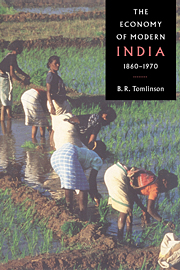Crossref Citations
This Book has been
cited by the following publications. This list is generated based on data provided by Crossref.
Sengupta, Subir
1996.
Understanding consumption related values from advertising: A content analysis of television commercials from India and the United States.
Gazette (Leiden, Netherlands),
Vol. 57,
Issue. 2,
p.
81.
Das, R.J
1998.
The social and spatial character of the Indian State.
Political Geography,
Vol. 17,
Issue. 7,
p.
787.
Amsden, Alice H.
1999.
Taiwan’s Development Experience: Lessons on Roles of Government and Market.
p.
95.
Das, Raju J
1999.
Geographical unevenness of India's Green Revolution.
Journal of Contemporary Asia,
Vol. 29,
Issue. 2,
p.
167.
Bayly, Susan
1999.
Caste, Society and Politics in India from the Eighteenth Century to the Modern Age.
1999.
Caste, Society and Politics in India from the Eighteenth Century to the Modern Age.
p.
306.
Das, R J
1999.
The Spatiality of Class and State Power: The Case of India's Land Reforms.
Environment and Planning A: Economy and Space,
Vol. 31,
Issue. 12,
p.
2103.
Zachariah, Benjamin
1999.
British and Indian Ideas of ‘Development’: Decoding Political Conventions in the Late Colonial State.
Itinerario,
Vol. 23,
Issue. 3-4,
p.
162.
Austin, Gareth
2000.
Markets, democracy and African economic growth: Liberalism and Afro-pessimism reconsidered.
The Round Table,
Vol. 89,
Issue. 357,
p.
543.
Adams, John
2001.
Culture and Economic Development in South Asia.
The ANNALS of the American Academy of Political and Social Science,
Vol. 573,
Issue. 1,
p.
152.
Rock, Marilyn
2001.
Globalisation and Bangladesh: The case of export‐oriented garment manufacture.
South Asia: Journal of South Asian Studies,
Vol. 24,
Issue. 1,
p.
201.
Robb, Peter
2002.
A History of India.
p.
246.
Adams, John
2002.
India's economic growth: How fast? How wide? How deep?.
India Review,
Vol. 1,
Issue. 2,
p.
1.
Thompson, Andrew
and
Magee, Gary
2003.
A soft touch? British industry, empire markets, and the self‐governing dominions, c.1870–1914.
The Economic History Review,
Vol. 56,
Issue. 4,
p.
689.
Kohli, Atul
2004.
State-Directed Development.
Rosser, J Barkley
and
Rosser, Marina V
2005.
The Transition between the Old and New Traditional Economies in India.
Comparative Economic Studies,
Vol. 47,
Issue. 3,
p.
561.
Austen, Ralph A.
and
Smith, Woodruff D.
2006.
The Economic Value of British Colonial Empire in the Seventeenth and Eighteenth Centuries.
History Compass,
Vol. 4,
Issue. 1,
p.
54.
Austen, Ralph A.
and
Smith, Woodruff D.
2006.
The Economic Value of British Colonial Empire in the Seventeenth and Eighteenth Centuries.
History Compass,
Vol. 4,
Issue. 1,
p.
54.
Majumdar, Sumit K.
and
Sen, Kunal
2007.
The debt wish: Rent seeking by business groups and the structure of corporate borrowing in India.
Public Choice,
Vol. 130,
Issue. 1-2,
p.
209.
Misra, Maria
2008.
Colonial officers and gentlemen: the British Empire and the globalization of ‘tradition’.
Journal of Global History,
Vol. 3,
Issue. 2,
p.
135.



